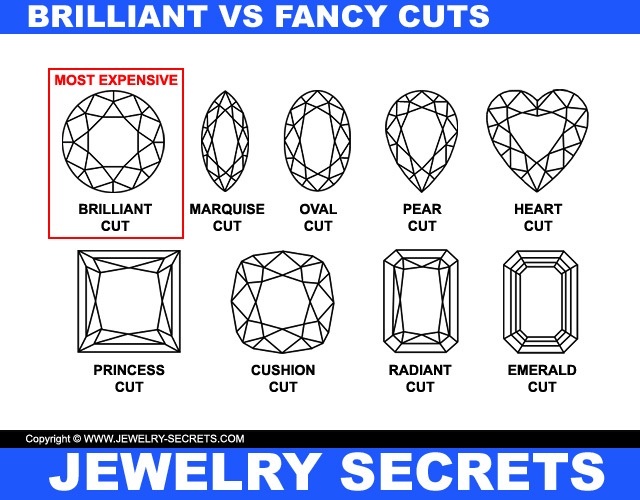Diamond Shapes And Cuts

Image source: https://www.jewelry-secrets.com/Blog/wp-content/uploads/2016/06/Diamond-Shapes-And-Cutting-Styles.jpg
Asscher Cut
The Asscher cut has started to become popular rather recently. The Asscher cut is today's more up-to-date version of the older cushion cut. This stone is the square to rectangular shape with a flat table. Similarly to the cushion, the Asscher cut will have an open cutlet, which is the facet on the bottom of the diamond. There are small step cuts on the top part of the diamond and more expansive facets below the stone.
Round Brilliant Cut
This is the most classic and timeless of all diamond shapes. More than 75% of diamonds distributed for engagement rings or in jewelry are round brilliants. The round brilliant diamond is the most brilliant diamond shape available. A modern round brilliant always has 58 facets, whereas an antique round brilliant only has 57, because they are not faceted with cutlets. There are 33 facets on the crown, which is the top portion of the diamond. There are 25 facets on the lowermost portion of the diamond, referred to as the pavilion.
Emerald Cut
Emerald Cuts are rectangular shaped diamonds that have trimmed corners. Flaws are with less trouble noticed in this cut than others, because emerald cuts have fewer facets and reflect less light. Emerald cuts have anywhere from 50 to 58 facets. Emerald cuts set in engagement rings are often found set with a smaller emerald cut on either side to balance out the design and style.
Marquise Cut
Marquise Cuts also have 58 facets, and other transparent stones may also be found in the marquise shape. When evaluating or shopping for a marquise, pay attention to sharp sides and points, as these can make it easy for the diamond to chip or damage. Narrow and long stones are favored to break. The ideal ratio for length to width in marquise cuts is 1.5.
Heart Shape
The heart shape diamond is also a brilliant cut diamond containing 57 facets. It is very similar to the pear shape. The only discrepancy will be that it would have a cleft up on the top of it. The cleft is the part between each half of the heart. The ideal shape for a heart is beautifully symmetrical. Color may be more effectively seen at the corners of the heart shape.
Cushion Cut
Also categorised as "pillow cut", this has been one of the most widely used diamond shapes that has ever been created. This shape ranges from rectangular to square, and has larger facets with rounded corners. There's an open cutlet found on the bottom of the antique ones, consistently. This gives the diamond the external appearance of greater depth. The fact that the facets are so large makes the clarity grade more obvious. Cushion cuts are not quite as brilliant as modern round brilliants.
Princess Cut
Princess Cuts will be square diamonds. These cuts are intended to give off the same amount of sparkle as a round brilliant. This shape was invented relatively recently, in terms of industry history, and consists of a rectangular or square table, which is the large flat facet towards the top of the diamond. This is a popular style when set in a solitaire engagement ring setting. A princess cut diamond will present anywhere from 45 to 58 facets. The four corners of a princess cut diamond must always be covered with prongs for protection against chipping. Girdles which are too thin shall most certainly have problems over time, due to the fact that they will be vulnerable to chipping. Another thing to be aware of is that princess cuts commonly appear somewhat smaller than diamonds of the same weight in other shapes. The majority of the weight is hidden in the bottom part of the diamond, called the pavilion.